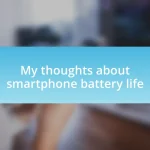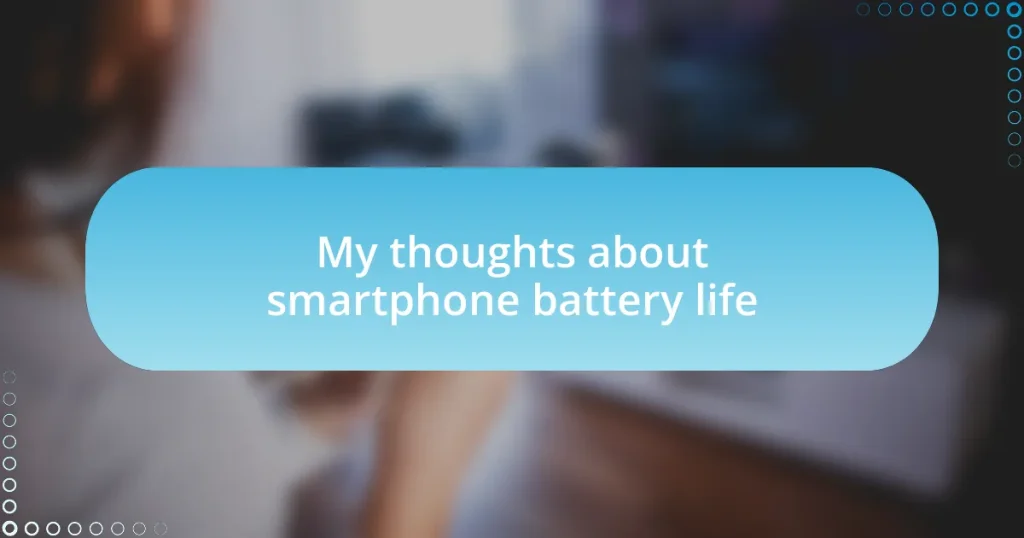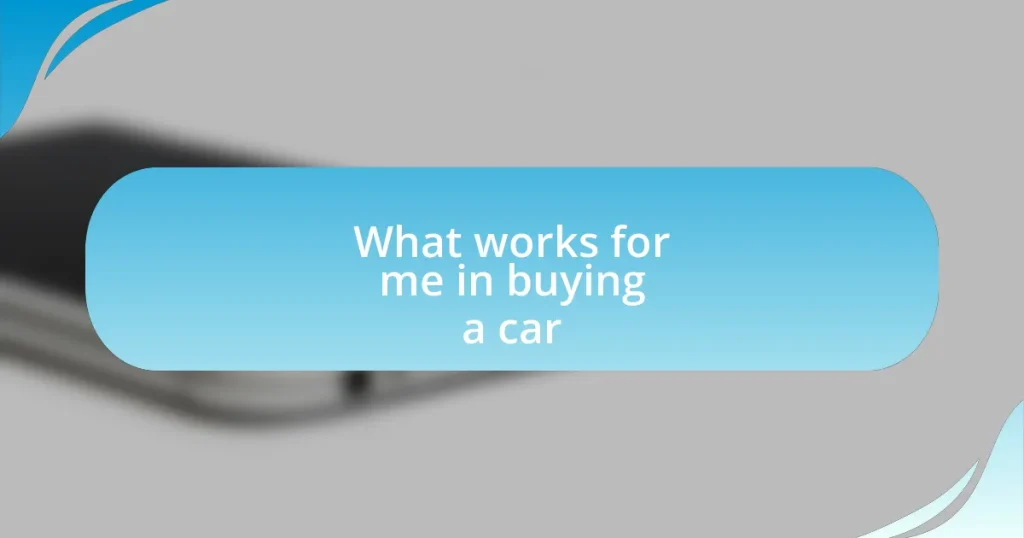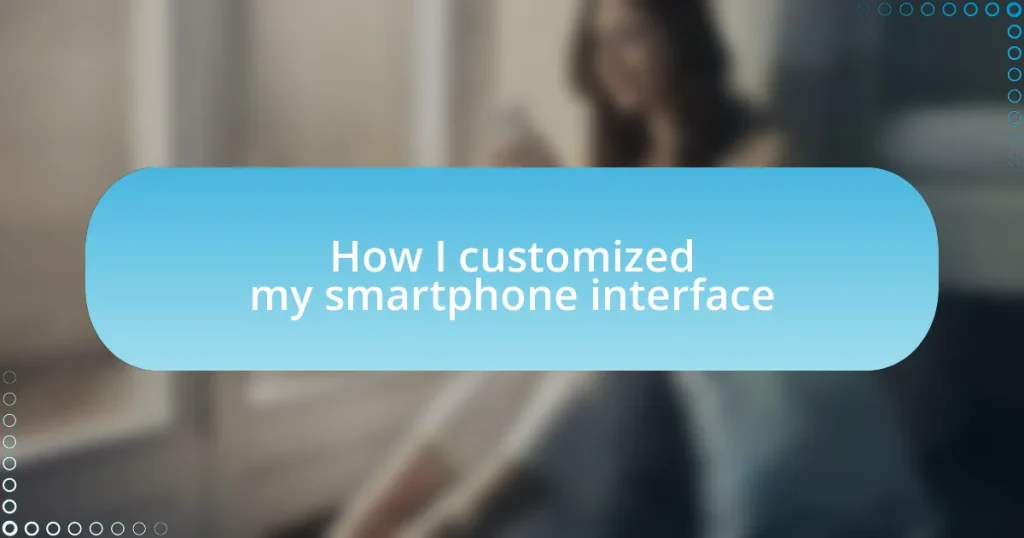Key takeaways:
- Smartphone battery life is influenced by factors such as screen brightness, background apps, and location services.
- Proper charging practices, like avoiding overnight charging and using the right charger, can significantly enhance battery lifespan.
- Monitoring charging patterns and utilizing diagnostic tools are essential for diagnosing battery health issues.
- Future trends in battery technology, including solid-state and graphene batteries, promise longer life and faster charging, alongside environmental benefits.
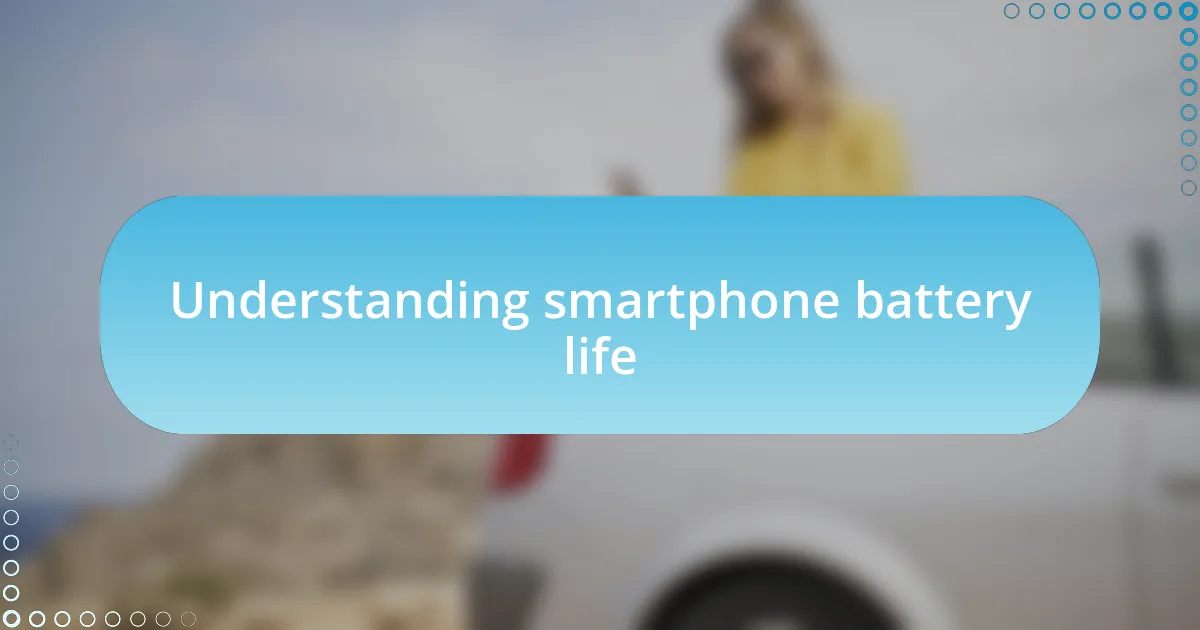
Understanding smartphone battery life
Understanding smartphone battery life can feel like unraveling a puzzle. I remember the frustration of watching my battery percentage plummet while I was out and about, completely immersed in my day. It got me thinking—why does this happen?
Battery life is influenced by numerous factors, from screen brightness to app usage. One day, I found myself streaming videos on my phone, and it drained my battery faster than I expected. Have you ever noticed how that seemingly innocent game or social media app can sneakily consume your battery without warning? It’s a common scenario that reminds us to be mindful of what we’re using.
Moreover, the specific capacity of your smartphone’s battery, often measured in milliamp hours (mAh), plays a significant role in how long it lasts. Whenever I invest in a new device, I always check the mAh rating because I know it directly impacts my day-to-day usage. It’s like comparing the fuel tank of a car—more capacity often means fewer trips to recharge, which is crucial for keeping up with a busy lifestyle.

Factors affecting battery performance
Battery performance is affected by several intertwined factors, and understanding them can help you make more informed decisions about your smartphone usage. For instance, I’ve experienced days when my phone seemed to drain faster, and it often came down to a few key culprits. It’s fascinating how something as simple as background app activity can significantly impact battery life.
Here are some factors that can influence battery performance:
- Screen Brightness: Keeping your screen at bright levels during the day or using dynamic brightness can rapidly drain your battery.
- Background Apps: Apps running in the background can consume power, even when you’re not actively using them.
- Location Services: GPS and location tracking services often keep your battery working overtime.
- Network Signal: A weak signal forces your phone to work harder to maintain connectivity, consuming more energy.
- Battery Age: As batteries get older, their capacity diminishes, which can lead to shorter overall battery life.
I remember the time I was on a road trip, and my navigation app was running while I was listening to music. By the time I reached my destination, my battery life was almost entirely depleted. It was a stark reminder of how quickly these factors can add up and affect my phone’s endurance.

Tips for improving battery longevity
I’ve found that adjusting screen brightness can have a huge impact on battery longevity. When I switched my settings to automatic brightness, I noticed a marked difference in how long my phone lasted throughout the day. It’s amazing how just finding that right balance can prevent the frustration of running low on battery unexpectedly.
Another tip is to manage background apps effectively. I remember a time when I left a few apps running while multitasking – by the end of the day, my battery was begging for mercy. Nowadays, I routinely close apps I’m not using and even disable certain features that hog power. The effort really pays off.
Lastly, consider disabling location services when you don’t need them. I once forgot to turn off my GPS while on a leisurely walk. My phone drained much quicker than I anticipated, and I was left scrambling for a charger later. Now, making it a habit to turn off location settings when I’m not navigating keeps my device alert and ready when I need it.
| Tip | Impact on Battery Longevity |
|---|---|
| Adjust Screen Brightness | Reduces energy usage significantly |
| Manage Background Apps | Prevents unnecessary power drain |
| Disable Location Services | Conserves battery life during idle periods |
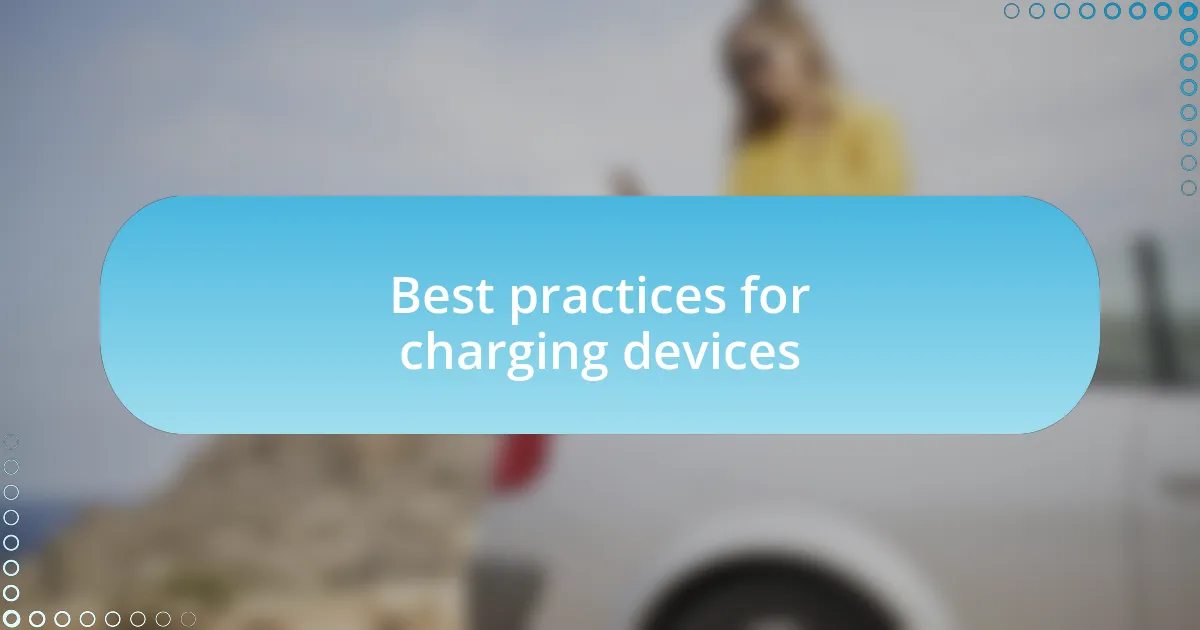
Best practices for charging devices
Charging your smartphone properly can make a significant difference in battery life. I’ve learned that charging overnight might seem convenient, but it can lead to overcharging. The first time I woke up to realize my battery was consistently at 100% for hours, I felt a wave of anxiety about its long-term health. Instead, I now set my phone to charge for a couple of hours before bed, allowing it to race through charging without staying plugged in too long.
I also recommend using the right charger. When I once borrowed a friend’s knock-off charger, my phone heated up too quickly for comfort. I quickly realized that not all chargers are created equal. Investing in the manufacturer’s recommended charger not only ensures safety but also helps maintain optimal charging speeds and efficiency.
Another key practice is to avoid using your phone while it’s charging. I used to scroll through social media as my phone powered up, but I noticed that this combination led to slower charging and excess heat. Now, I resist the temptation and let my phone focus solely on charging, while I catch up with my favorite book instead. How does that sound as a plan for a more efficient charge?

Diagnosing battery health issues
When it comes to diagnosing battery health issues, I often start by monitoring charging patterns. I recall a time when my smartphone seemed to drain power within hours, even with minimal usage. It was frustrating, and I learned the importance of keeping an eye on how long it took to charge and whether the battery percentages fluctuated unpredictably. This practice gave me insights into whether the problem lay with the battery itself or perhaps a specific app.
Another useful method for assessing battery health is to utilize built-in diagnostic tools. I remember discovering my phone’s settings menu had a feature that revealed battery usage statistics. It was like peering under the hood of my device—watching which apps drained the most energy opened my eyes to quick fixes, such as uninstalling a few power-hungry apps that I hardly used anymore. Have you checked yours yet? It might surprise you how much clarity these tools can provide.
Finally, physical signs can indicate deeper battery issues. Once, I noticed my phone was noticeably warmer than usual while charging, which set off alarm bells for me. This experience prompted me to investigate further and led to getting my battery tested at a service center—something I now recommend to anyone encountering odd behavior. Recognizing these cues can save you a lot of stress in the long run.
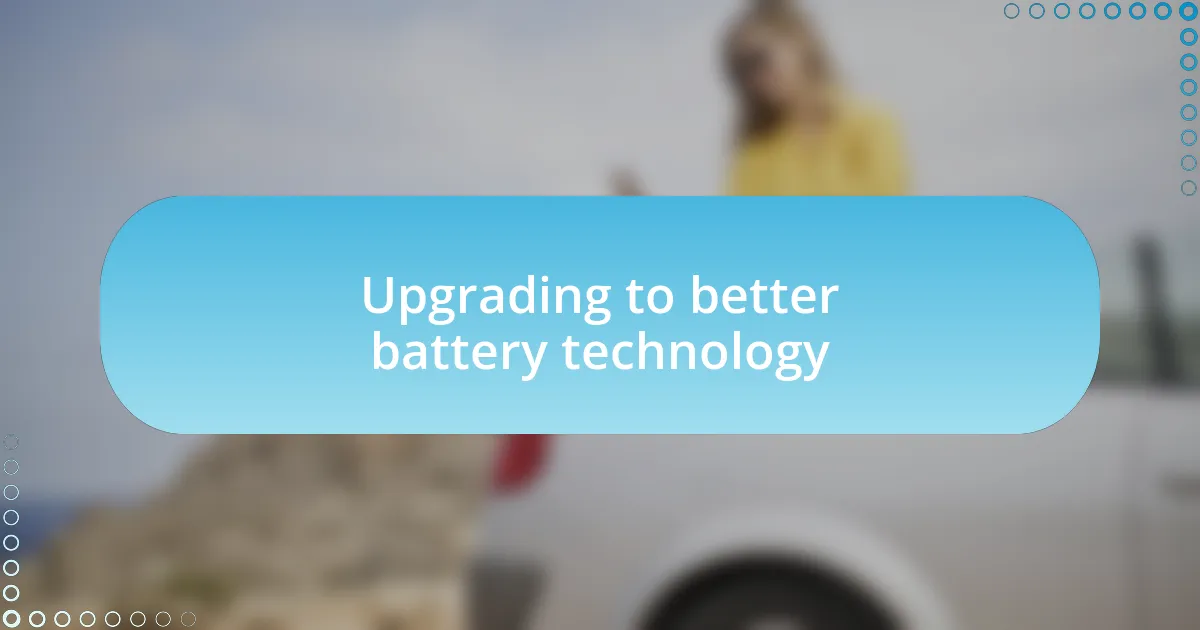
Upgrading to better battery technology
Upgrading to better battery technology is something I’ve been keenly interested in. I recall the excitement I felt when I first tried a device featuring solid-state batteries. The device seemed to last longer on a single charge, and it had a faster recharge time, which transformed how I used my phone throughout the day. Have you ever wished your phone could keep up with your busy lifestyle? Solid-state batteries promise just that, delivering improved energy density and durability compared to traditional lithium-ion batteries.
Moreover, I’ve been following the developments in graphene batteries with great enthusiasm. When I first read about their potential, I was amazed. Graphene batteries could not only charge much faster but also last significantly longer than our current options. I mean, who wouldn’t want a phone that could go from zero to full charge in mere minutes? The prospect of such technology makes me hopeful for the future of our devices.
What fascinates me even more are the environmental implications of advancing battery technology. Transitioning to batteries that use less harmful materials could greatly reduce electronic waste. I remember pressure washing my old phones, feeling guilty about tossing them away as I saw their impact on the planet. Each step toward better battery technology could mean fewer discarded devices and caring for our environment—a thought that definitely resonates with me.
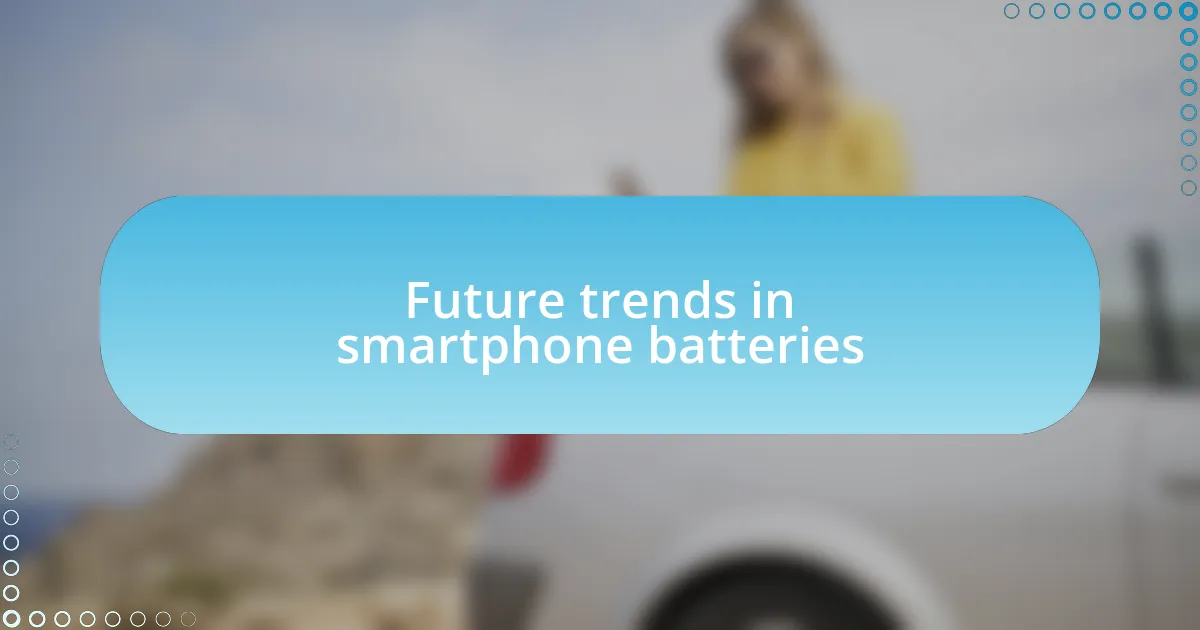
Future trends in smartphone batteries
As I think about the future of smartphone batteries, I can’t help but feel excited about advancements like lithium-sulfur batteries. Imagine a battery with much higher energy density that allows your phone to last several days on a single charge! I remember the thrill of discovering how battery technology could dramatically enhance users’ daily experiences and how these innovations might finally eliminate the dreaded 3 p.m. battery anxiety.
Another trend I see gaining traction is wireless charging technology, particularly through resonant inductive coupling. In the past, I often found myself searching for a charging cable in a bustling coffee shop. The idea of simply placing my phone on a surface to recharge feels revolutionary! This convenience could significantly change the way we interact with our devices, allowing us to charge up effortlessly without the need for countless cables and adapters.
Moreover, energy harvesting is an intriguing possibility. Have you ever thought about how much energy our everyday activities generate, like walking or even typing? I think it’s fascinating that future smartphones might be able to harness this kinetic energy to extend battery life. This innovation could not only add convenience but also make us more mindful of our energy consumption, turning a simple action into an opportunity for sustainability.








